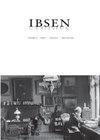Stories of “Infidelity”: Nazi Ibsen Adaptations and the Norwegian Press
IF 0.1
0 THEATER
引用次数: 0
Abstract
Considering the shocking themes, feminism, and critique of idealism in Henrik Ibsen’s plays, the fact that only adaptations of Ludwig Ganghofer’s homeland novels premiered more often in the Nazi era presents puzzling paradoxes to film historians and readers of Ibsen alike (Drewniak 1987, 562; Holt 2020, 303). How did it come to be that this revealer of social ills and lies was used by a film industry notorious for its deceitful propaganda? Ibsen’s independent women, like Nora and Lona Hessel, can hardly be imagined as role models for the “Aryan housewife.” Minister of propaganda Joseph Goebbels, who orchestrated film production in Nazi Germany, preferred Knut Hamsun and considered Ibsen outdated, according to his diaries. This Zeitgeist notwithstanding, a “wave” of five Ibsen adaptations premiered in Germany between 1933 and 1945 – a period that saw a marked decrease in Ibsen adaptations globally (T€ ornqvist 1994, 205). Despite starring the biggest male film stars of the era and being produced by some of the top talent remaining in the German film industry, the Ibsen adaptations in the Third Reich have mostly languished in film historical obscurity. One likely reason is the relative unavailability of the films, which for the most parts are hidden in archives, unavailable in official versions on the commercial market. In a recent PhD dissertation on Ibsen and Nazi cinema, I erroneously claim that none of these adaptations premiered in Norway (Holt 2020, xxvi). In fact, four Nazi era adaptations screened in Ibsen’s homeland during the 1930s“不忠”的故事:纳粹易卜生的改编与挪威出版社
考虑到亨利克·易卜生戏剧中令人震惊的主题、女权主义和对理想主义的批判,只有路德维希·冈霍夫的祖国小说的改编才更经常在纳粹时代首演,这一事实给电影史学家和易卜生的读者带来了令人费解的悖论(Drewniak 1987, 562;霍尔特2020,303)。这个社会弊病和谎言的揭露者是如何被一个以欺骗性宣传而臭名昭著的电影工业所利用的?易卜生笔下的独立女性,比如诺拉和洛娜·埃塞尔,很难被想象成“雅利安家庭主妇”的榜样。在纳粹德国策划电影制作的宣传部长约瑟夫·戈培尔(Joseph Goebbels)的日记显示,他更喜欢克努特·哈姆生,认为易卜生已经过时了。尽管有这种时代精神,易卜生的五部改编作品在1933年至1945年间在德国首演,而在这一时期,易卜生的改编作品在全球范围内明显减少(T€ornqvist 1994,205)。尽管由当时最大牌的男电影明星主演,并由德国电影业的一些顶尖人才制作,但第三帝国时期易卜生改编的电影大多在电影史上默默无闻。一个可能的原因是这些影片的相对不可获得性,其中大部分隐藏在档案中,无法在商业市场上获得官方版本。在最近一篇关于易卜生和纳粹电影的博士论文中,我错误地声称这些改编作品都没有在挪威首映(Holt 2020, xxvi)。事实上,在20世纪30年代,易卜生的家乡放映了四部纳粹时代的改编作品
本文章由计算机程序翻译,如有差异,请以英文原文为准。
求助全文
约1分钟内获得全文
求助全文

 求助内容:
求助内容: 应助结果提醒方式:
应助结果提醒方式:


